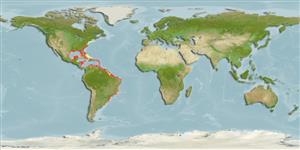Common names from other countries
Environment: milieu / climate zone / depth range / distribution range
Ecologia
marinhas associadas(os) a recifes; intervalo de profundidade 1 - 80 m (Ref. 5217). Subtropical; 42°N - 35°S, 98°W - 28°W
Western Atlantic: North Carolina, USA, the northern Gulf of Mexico and the Bahamas southward to Uruguay. Occurrence in western Caribbean is doubtful (Ref. 26938).
Length at first maturity / Tamanho / Peso / Idade
Maturity: Lm 12.9 range ? - ? cm
Max length : 30.0 cm TL macho/indeterminado; (Ref. 7251); common length : 16.0 cm TL macho/indeterminado; (Ref. 5217)
Espinhos dorsais (total) : 10; Raios dorsais moles (total) : 12; Espinhos anais: 3; Raios anais moles: 7 - 8. Body pale brown dorsally with several vertical dark brown bars, becoming white ventrally; dorsal fin dusky with longitudinal yellow lines; pectoral, pelvic and anal fins dusky; caudal fin dusky with small yellow blotches (Ref. 13608). Preopercle has spines radiating from 2 centers (Ref. 26938).
Inhabits bays, coastal grassy areas and shallow banks. Solitary (Ref. 26340) and retreats into shelter when frightened (Ref. 9710). Neither opercular spine nor anterolateral glandular grooves with venom gland is present (Ref. 57406). Synchronously hermaphroditic. Popular as a pan fish despite its small size.
Life cycle and mating behavior
Maturities | Reprodução | Spawnings | Egg(s) | Fecundities | Larvas
Simultaenous hermaphrodite. The gonad contains ovarian and testicular tissue separated by a thin basement membrane, with no means of internal self-fertilization.
Robins, C.R. and G.C. Ray, 1986. A field guide to Atlantic coast fishes of North America. Houghton Mifflin Company, Boston, U.S.A. 354 p. (Ref. 7251)
Categoria na Lista Vermelha da IUCN (Ref. 130435)
CITES (Ref. 128078)
Not Evaluated
Utilização humana
Pescarias: espécies comerciais; peixe desportivo: sim
Ferramentas
Relatórios especiais
Descarregue XML
Fontes da internet
Estimates based on models
Preferred temperature (Ref.
115969): 21.9 - 28, mean 25.2 (based on 542 cells).
Phylogenetic diversity index (Ref.
82804): PD
50 = 0.5002 [Uniqueness, from 0.5 = low to 2.0 = high].
Bayesian length-weight: a=0.00912 (0.00746 - 0.01115), b=3.10 (3.06 - 3.14), in cm Total Length, based on LWR estimates for this species (Ref.
93245).
Nível Trófico (Ref.
69278): 4.5 ±0.0 se; based on diet studies.
Resiliência (Ref.
120179): Elevada, tempo mínimo de duplicação da população menor que 15 meses (K=0.29-1.5; tm=1.01).
Fishing Vulnerability (Ref.
59153): Low vulnerability (15 of 100).
Climate Vulnerability (Ref.
125649): Moderate vulnerability (36 of 100).
